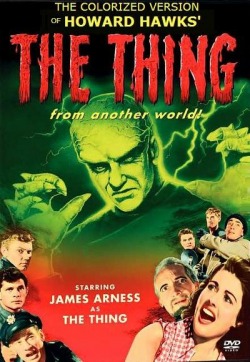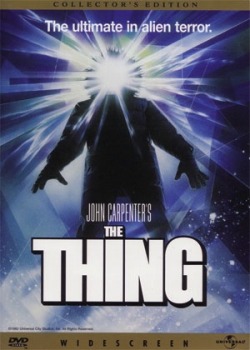
 Doing comparisons between a film and its remake seem to be a fruitful path.
Doing comparisons between a film and its remake seem to be a fruitful path.Howard Hawk's 1951 film The Thing From Another World carries with it a theme particular to horror and science fiction films of that era. It appears that following the deployment of the atomic bomb in 1945, America came to villify science and scientists in its cultural output. The postwar period saw the birth of science fiction, and horror moved away from the gothic tales that had defined the genre. Film traded vampires for mad scientists.
But America was still on the upswing following WWII, and the military was commonly favored as the heroic saviors of mankind. The Thing From Another World presents a claustrophobic play between soldiers and aliens, yes, but also a subplot between soldiers and scientists. The scientist insists that The Thing be preserved alive for the sake of science, throwing the rest of the camp into peril. The soldier characters must overcome the meddling scientist and prevent him from abetting their more dangerous adversary.
This pro-military, anti-intellectual theme is reversed in John Carpenter's remake from 1982, simply titled The Thing. Concurring with other horror films from the post-Vietnam era (George Romero's Day of the Dead comes to mind), Carpenter portrays the military characters negatively, mired in the chain of command and divorced from the well-being of anyone they outrank. The film portrays scientific knowledge as an exponent of rationalism, which constantly conflicts with the irrationality of the soldier-types.
Curiously, the 1951 feature concludes with victory, while the 1982 remake ends with the almost certain failure of the characters to preserve themselves, or the rest of humanity. This certainly reflects our countries major military conflicts. In 1951, America was unbeaten and invincible, thanks to military bravery. By 1982, Americans had felt defeat in Vietnam, and the country was left feeling defeated and used. Because most conflicts since have played out in largely the same fashion, many horror films since have fallen between two poles of nihilistic resignation to certain doom (sad endings) and reactionary revenge fantasies (happy endings, see last entry).
Also, it is a great honor to have John Kenneth Muir as a "follower" of this blog. Please check out his pages!
I'm very much enjoying your blog, and glad that I came across it. Already a lot of stimulating and interesting ideas here.
ReplyDeletebest,
John Kenneth Muir
I probably need to see the The Thing From Another World again(it's been a while), but to me, it shouldn't be accredited with following the same plot as the original John W. Campbell Story. Carpenter's adaption is arguable (by me) the one that should be the only true adaption.
ReplyDeleteWhat do you think?
Andrew:
ReplyDeleteCampbell's story is on my reading list, so I can't really disagree with you! But based on what I know about the original, Carpenter's is definitely the "real" adaptation.
Of course, perhaps Hawks' film is just "more adapted" than its successor? It kind of puts me in mind of the supposed relationship between Alien vs. Predator and Lovecraft's "At the Mountains of Madness," another book I've yet to read.
I'll have to finish reading "At the Mountains of Madness" and then we can discuss that. It seems plausible from what I've read so far that there could be a real connection between the two.
ReplyDeleteThat seems to be the case, Though if the screenwriters really did claim to base the plot off of the Campbell story, it definitely lowers my opinion of them. I mean, as much as I can for Hollywood drones. (Hate the game, not the players!)